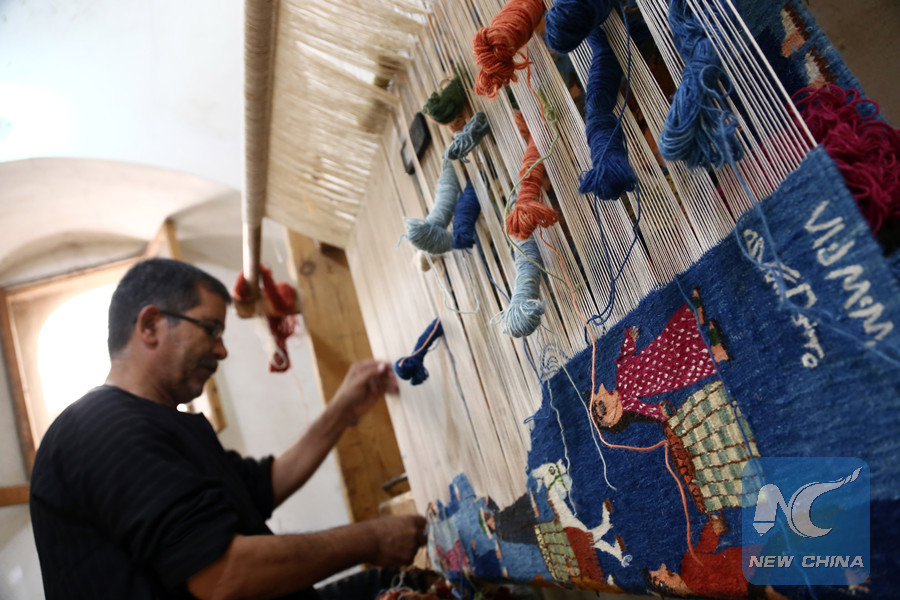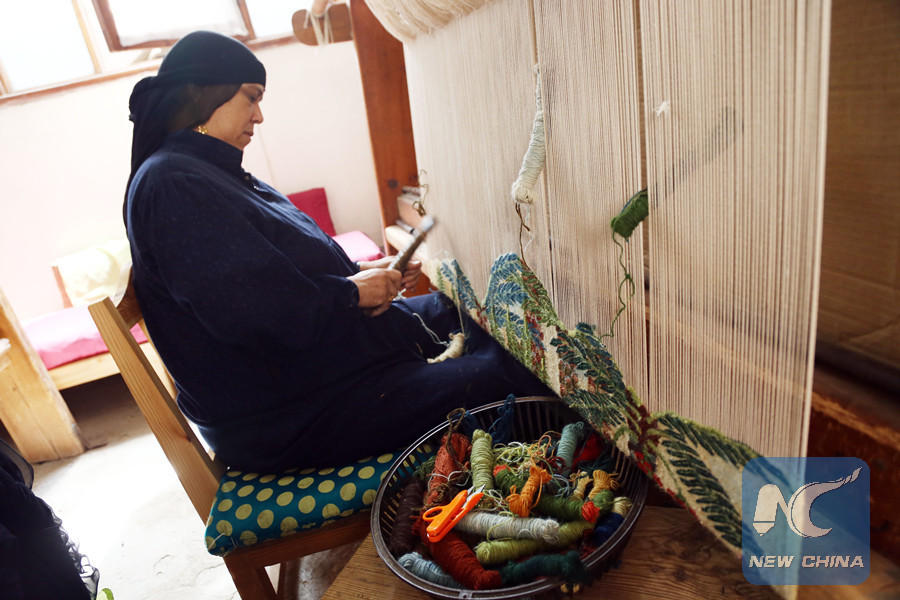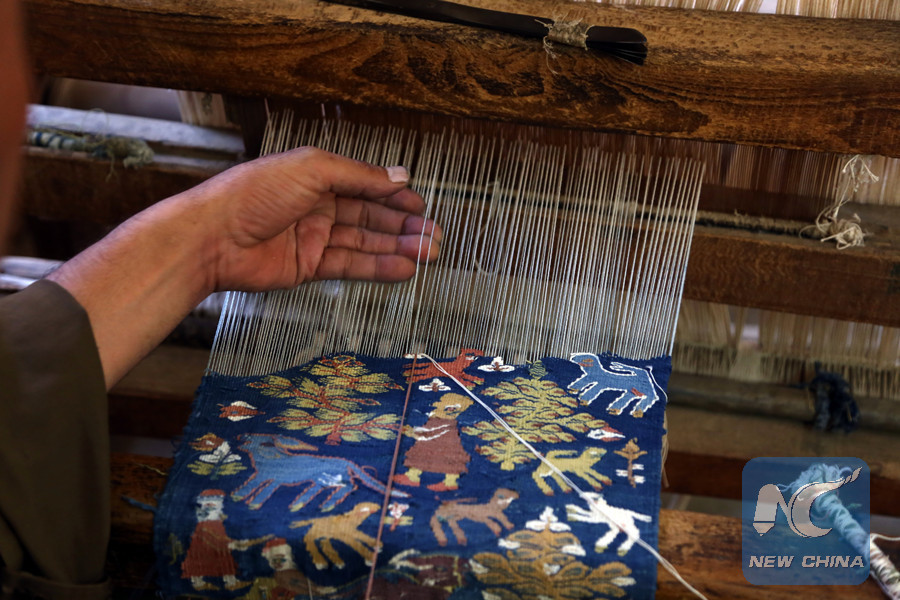
A man works in Ramses Wissa Wassef Art Center in Giza, Egypt, on Oct. 9, 2018. (Xinhua/Ahmed Gomaa)
CAIRO, Nov. 13 (Xinhua) -- Occupying a vast area of green land and surrounded by a large fence in Harrania village on the outskirts of Giza near the Egyptian capital Cairo, world famous Ramses Wissa Wassef Art Center (RWWAC) stands as a distinguished venue for artistic handmade tapestry production in Egypt.
The classic local-style two-storey building with its adjacent short premises hosts 35 male and female weavers working on unique landscape tapestries.
The center, whose works toured most of the world's big capital cities, was established in 1952 by late architect and art professor Ramses Wissa Wassef.

A woman works in Ramses Wissa Wassef Art Center in Giza, Egypt, on Oct. 9, 2018. (Xinhua/Ahmed Gomaa)
"Wassef came from downtown to the poor village with his classy car, bought a piece of land with an area of about 2,000 square meters and started to build the center with an eye of an architect," RWWAC manager Ikram Nosshi told Xinhua in a tour inside the center.
Wassef gathered children of the village around him, gained their trust through building a soccer playground for them, then he started to teach them weaving as a new skill for them through which they can express themselves and make a living at the same time.
"Wassef had a broader vision on the concepts of art, humanity and unique individual potentials. He had a firm belief that every human being is created with energy for creativity by nature," Nosshi, who is also Wassef's son-in-law, narrated.

A man works in Ramses Wissa Wassef Art Center in Giza, Egypt, on Oct. 9, 2018. (Xinhua/Ahmed Gomaa)
The center features unique tapestries of landscape and rural life scenes including greeneries, gardens, palm trees, canals, birds, sheep and marketplaces, depicted by the farmer-turned-artists raised by Wassef and his daughters Suzanne and Yoanna after his death.
"Their works have been displayed in exhibitions at specialized museums and venues in almost all big capital cities in Europe, including London, Paris, Rome, Stockholm, Helsinki, Amsterdam and The Hague and Berlin," said RWWAC manager.
Nosshi noted that the center has one unique piece of each work. There are no copies or models to copy from.
"The personality of each artist is reflected on his works," he said.
"Once, we had an exhibition that toured the United States for two years, and it was host by big museums there including the Metropolitan in New York and the Textile Museum in Washington," he added.
Nosshi pointed out that that the idea to build the center started by Wassef in late 1930s and the center started operation in 1952.
"The center's first exhibition was held in the French cultural centers in Cairo, Alexandria and Ismailia, which was the first exposure of Wassef's works to foreign communities," he explained.
The first invitation to hold an exhibition outside Egypt was in Switzerland in 1958, when cultural and art communities in Egypt started to know more about Wassef's experience.
"Sometimes, our artists are invited to exhibitions abroad carrying small looms to work in front of the visitors who couldn't believe that the creative tapestries are their own imagination-based production without drawings to copy," said RWWAC manager.
Nosshi explained that the first generation started with 14 boys and girls, most of them are over 70 years old now and two of them are still working in the center, while the second generation started from 1972 with Suzanne and Yoanna.
"So, we have currently about 35 male and female weavers in the center, working in about 15 rooms, two in each room with two large looms," he added.
The sizes of tapestries are various, including 1m x 1.5m and 1m x 2m. Some are landscape shaped and others are portraits. There are two tapestries each consisting of three pieces and the total size of each is 2.5m x 7m.
"Each tapestry of the two big ones took three years and a half to finish," Nosshi said.
One of them is called "Egypt," featuring natural scenes from the southern province of Aswan to the capital Cairo, including the Nile River, the boats and the surrounding landscape. It's installed on a wall in the Egyptian presidential palace that was renewed in 1990.
It was made by Ali Selim, a 70-year-old veteran weaver from the first generation.
The other huge tapestry is kept in the museum attached with the center that displays the work development of each artist since they started joining the center until they mastered weaving.
"I started working here since I was 9. So, I have been working here for more than 60 years now," Selim told Xinhua while holding threads of several colors and working on a tapestry on his large loom.
"What distinguishes our work is that it has a spirit, unlike those produced by advanced technology. This is why Westerners were bedazzled by our tapestries when I travelled with exhibitions to some European countries like Britain and Germany," he added.
Tahiya, a lady from the second generation of farmer-turned-artists, has been working for RWWAC for 28 years. She is now in the early stage of weaving a tapestry containing trees and flowers.
"This little part took me two months and the whole tapestry is expected to be finished in six months," Tahiya told Xinhua in front of her loom.
"All my tapestries are based on my imagination and the surrounding nature. I love them all and I find that each of them is always better than the previous one," she added, stressing that she feels at home at the art center.

